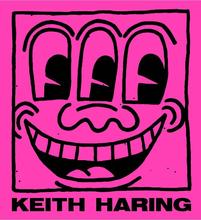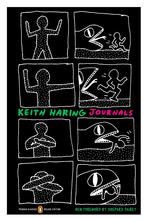Keith Haring was one cool dude, and his signature doodles are enough to stop you in your tracks whenever you see them.
What else would you expect from a guy who was friends with 1980s New York City art royalty, like Kenny Scharf, Jean-Michel Basquiat, and – reigning supreme – Andy Warhol? Imagine being a 20-year-old, nerdy-looking guy who just hopped off a bus from Pittsburgh and finding yourself in Manhattan. New York has always been a hotbed for anything and everything hip, and Haring arrived at just the right time to hang with the cool kids.
Before public art reached the level of shiny, multi-million-dollar beans, Haring was drawing wiggly, vibrating people in the stations that make up New York’s subway system. Even though Haring’s figures might appear child-like, many of his works have a more serious social and political bent to them. The early 1980s saw the beginning of the AIDS crisis in New York. At first, no one knew what it was – only that it was primarily affecting the gay community and that many friends and loved ones were dying of this mysterious disease. By 1985 when Haring made this painting, artists and activists assumed the responsibility themselves to get out into the streets to raise awareness because the good old American government was doing nothing to help those who were affected.
Haring developed a unique visual language that only exists within the world of these dancing, flying, and jumping outlines. In this case, the red X’s over the faces of these two men signify that they are HIV-positive. This painting basically says that we can all still have a good time, as long as we remember to be safe and protect ourselves and one another. As a gay man who eventually died of AIDS-related complications in 1990, Haring realized the importance of advocating for this cause. Another superb example of Haring’s public art still stands today. You can visit the Crack is Wack Playground in East Harlem and reflect on how Keith Haring really was an artist who championed the underserved, even if they weren’t the same high-profile art dudes he usually associated with.
We New Yorkers love public art, but graffiti is still unfortunately illegal here, which is why none of Haring’s doodles are still in the subway. We can thank Emily Fisher Landau and her amazing art collection for memorializing this work of Haring genius. In 2010, Landau gave this and 366 other works of art to the Whitney. Talk about a huge collection! Landau began collecting art in the 1960s, and as a beginner, she bought pieces by the usual suspects, like Picasso and Dubuffet. As she matured and entered the wild and crazy 1980s, Landau set her sights on more contemporary artists like Haring and Richard Prince, whose delightfully creepy Man Crazy Nurse #3 also comes from Landau’s collection.


















He made so many great artworks, this one seems so subpar compared to the others